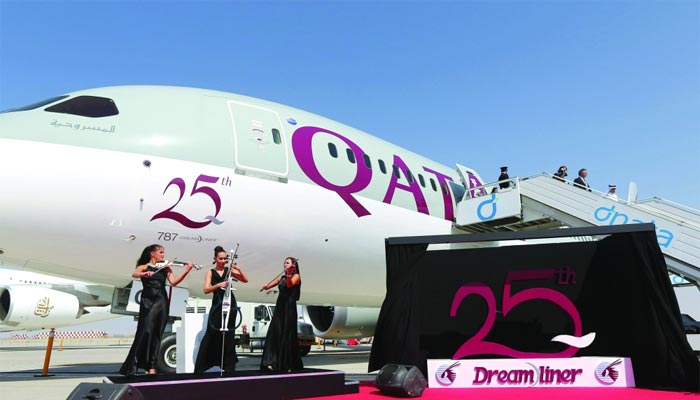Musicians perform next to the 25th unit of Boeing 787 Dreamliner received by Qatar Airways and dislayed at the Dubai Airshow last month. For 2016, the International Air Transport Association forecast the airlines fuel bill would fall to $135bn, which represent 20.6% of their total operating costs.
The aviation industry first goal was to “continue to improve fuel efficiency” across the fleet by an average of 1.5% a year until 2020, according to a senior IATA official.
“This is already bearing fruit. In fact, the industry is currently tracking ahead of our goal, with an average fuel efficiency improvement of 2.9% per year. That’s a cumulative fuel efficiency improvement since 2009 of 13.6%,” said Michael Gill, IATA director (Aviation environment).
The second would be to stabilise net carbon dioxide (CO2) emissions from aviation at 2020 levels, Gill said at the ‘IATA Global Media Day’ in Geneva recently.
This carbon-neutral growth is an effort by the industry to acknowledge that many countries want to continue their aviation development – to ensure trade and tourism into the future – but it needs to balance that with climate action. The concept allows the industry to keep feeding economic activity and also cap our emissions.
“This goal will be addressed not only through the technological, operational and infrastructural advancements, but most importantly through the development of a global market-based measure at the UN’s International Civil Aviation Organisation (ICAO),” he said.
The third goal, Gill said was to look out to 2050 when the industry aimed to be down to half of what its CO2 emissions were in 2005.This is much longer-term than the previous two, but aviation partners are already working together to put in place the building blocks to achieve it.
“Reducing aviation’s net CO2 emissions by 50% by 2050 is certainly ambitious. We are concentrating action in two key areas: a combination of technological advancements and the development of sustainable alternative fuels. To date, no other industry has been able to agree and put forward targets like these at the global level,” Gill said.
For 2016, the International Air Transport Association forecast the airlines fuel bill would fall to $135bn, which represent 20.6% of their total operating costs.
Jet fuel prices have fallen substantially and IATA based its forecast on an average price of $63.8 a barrel next year, and $51 a barrel for the Brent crude.
“The future price of oil is highly uncertain, with some forecasters expecting $20 per barrel in 2016 while others expect a rise to $60 per barrel. Certainly, record oil inventories suggest a significant rise in 2016 is highly unlikely, but expected stronger economic growth should pull prices up from current levels later next year,” IATA chief economist Brian Pearce said.
Fuel is such a large cost that it focuses intense effort in the industry to improve fuel efficiency, through replacing fleet with new aircraft, better operations and efforts to persuade governments to remove the airspace and airport inefficiencies that waste around 5% of fuel burn each year.

